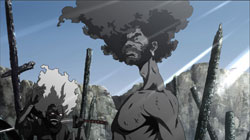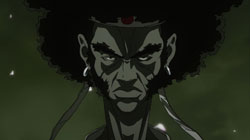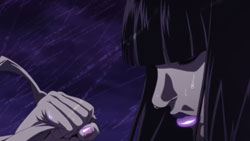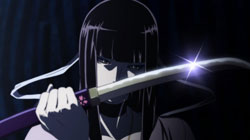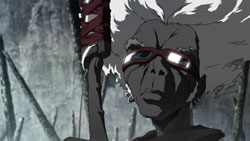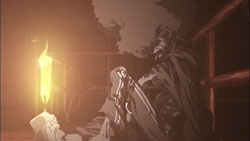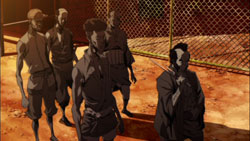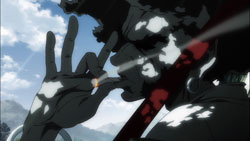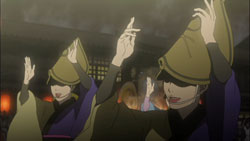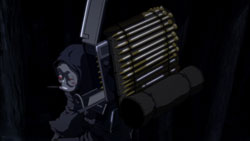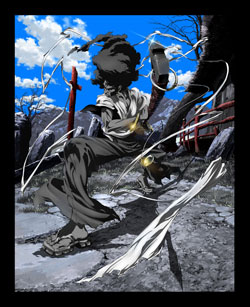 Logo handmade by Bannister
Column by Scott Green
Logo handmade by Bannister
Column by Scott Green
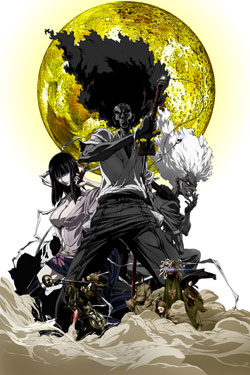
Anime Spotlight: Afro Samurai: Resurrection Released FUNimation
Regarding the continued success of Dragon Ball Z, FUNimation representatives are fond of saying that a new adolescent boy is born every day. Some kid is always hitting the stage where their interest is ignited by screaming super hero martial artists and planet cracking fireballs. By the same token, there's a time in the life of a guy where they're primed for being awed by a Vampire Hunter D, a Guyver, a Wicked City or a Ninja Scroll. Back in the day, anime provided the fix for stories in which a hero unleashed pit-bull ferocity on a world of threatening weirdness. You could generally count on a friend's VHS tape, a Blockbuster shelf, or if you were hard-up, a diluted version airing on Sci-Fi channel for some brilliantly gruesome Yoshiaki Kawajiri flick. However, with the rise of CG augmented movies like 300 and the maturation of gaming technology, with the fall of the business model for direct to video OVAs, this type of slickly graphic assertion of machismo moved away from anime. Sure, you'd get the late night treat like Berserk, Devilman Lady or Soul Taker, but this framework largely stopped being the domain of anime.With Afro Samurai, Yoshiaki Kawajiri has witness a blistering return to form. Yes, it's fundamentally limited in its sophistication. Yah, I'm inclined towards incredulity when bonus material captures show creator Takashi "Bod" Okazaki claiming profound significance behind the plot and comparing the arc envisioned for his hero to Osamu Tezuka's Phoenix cycle. It may be indicative of something when a cameo situates Okazaki between two women in a strip club scene. Still, I have to say that I'm very fond of the anime. It's a very globally marketable idea done very well. The mash-up of sword on sword chanbara cinema versus pop media depictions of African American culture, the expansive set pieces and the baroque fight scenes all ensure that Afro Samurai strikes the right cord to command the attention of the "holy shit! Did you just see that!" age viewer. At the same time, it has the flare and style to rack up points with the jaded viewer who seen the graphically violent OVAs of the 80's and 90's, and isn't simply swayed by the repackaging of old tricks. The original Afro Samurai was an essentialized chambara revenge story. As a boy, Afro saw his father slain by the gunslinger Justice, for the "Number One" headband. As might be deduced by the name of the MacGuffin, the bearer of "Number One" is king of the hill. The person who possesses the "Number Two" can challenge "Number One", but carrying the "Number Two" makes the possessor the target for any and every swordsman with ambition. Afro lives a life consumed by the need to avenge his father's death. As he advances towards Justice, he's beset by every thug and maniacal organization able to draw to sword or build a killer-robot. And, as he nears his goal, the damage he's caused in his pursuit of vengeance blows back, into his path. Afro Samurai Resurrection is ostensibly what happens after Afro's achieved the goal that defined his life. According to the anime's creators, Resurrection is the story of Afro's efforts to accept his past, and as such, a deeper and darker journey than the first Afro Samurai. One of the many spider-web cracks of lives ruined by Afro's exploits, looking to revenge themselves on the swordsman is Sio. Voice by Lucy Liu, this busty schemer with a death's head banner over her shoulder works with previous antagonists, such as the teddy bear headed Sanjuro - Kuma and the limbless mad scientist Dharman, as well as a trio of hench-cyborgs: "funny mask" Bin (Mark Hamill), "lion mask" Michael and "Noh-mask" Tomoe. Not only do Sio and her followers force Afro out of his uninvolvement with world affairs by stealing the "Number One," they engineer to punish him by robbing his father's grave in order to resurrect and torture the one life that Afro valued. Afro's pursuit of the Number Two works in updated antagonists from his first go around with a remix of situations from the manga that were omitted from the earlier anime. Specifically, a Lone Wolf and Cub style swordsman with child in tow cross paths with Afro in a festival combining elements from Japanese folk celebrations and hip-hop. Then Afro comes to loggerheads with his new adversaries to great effect. In particular, our hero versus the cyborg trio is a circus of swords, missiles and flying bodies, worth the price of admission in its own right. There are several variants of the origin story behind the Afro Samurai anime that have gone around, but a common element hinges on an exec spotting a limited run Afro action figure on the work space of an artist at anime studio Gonzo. The figure in question was produced as a response to Takashi "Bob" Okazaki's original work from the dojin magazine Nounouhau. From the publication's description of itself NOUNOUHAU is a self-published comic magazine by young creators, who were just coming into action as artists in various fields like comic, illustration, animation, game and performance at that time, having the hope of set up their own media for their artistic self-expression. Now, each member is active in the front lines of Japanese pop culture. Their range of activities is expanding to not only art, comic and TV, but also world wide stages! In the case of the manga, Afro samurai utilized the medium to which it was applied as a platform rather than as an ends unto itself. Manga was the canvas for the design work first, and a vehicle for a story second. It resonated with the visual impact of a character who was Sweet Sweetback AND Nemuri Kyôshirô ... the samurai and the antihero of African heritage. Showcasing that conceptual thread, starting with Afro and continuing through MC yakuza, DJ monks and a teddy bear headed Yojimba, was the manga's Raison d'être. Afro Samurai's animators, Gonzo, take heat from North American anime enthusiasts for producing work that fails to live up to its apparent potential. There are almost universally well regarded counter examples, but there is also a reputation for burning viewers with series that look inspired for a few episodes before deflating and sizzle reels that don't represent the final product. In the case of Afro Samurai, Gonzo thrusts forward with no reservation. In the animation department, there's no cause to complain that Gonzo is holding back, skimping or underperforming. Springing off Okazaki's template, the anime starts with off-kilter covers of chanbara favorites... a duel in the center of a bridge, only rather than a pair of kimono clad samurai with water to their left and right, it's Afro with his cloud of hair hidden in a Fuke monk's woven mask versus a pair of synchronized croissard and breeches clad fencers. The hook to follow that jab is violence at anime velocity. In perspective, positioning of the human form and consequence, it's the flexibility of anime leveraged to the hilt. The camera dives into the point of impact. The view is inches from a nose as a sword is dodged by a fraction of that space. The frame catches the cross section of body parts as they fly off. The smallest ray of sunshine and looping bracelet obeys the whim of the animators. And then, there's the final barrage, in which the sensibilities and style spell out "only in anime. After seeing the original Afro Samurai, I remarked that the anime had one of the better Macross-like scenes of aerial combat that I'd seen in a while, and that something called "Afro Samurai" was the last place I'd expect to see that trope exercised. The second time around, it's far less a surprise, but no less a pleasure. Afro versus three cyborgs designed to kill him; featuring the exhilaration of rapid, mid-air maneuvers; a sword slicing through laser beams; a patch work man of metal and flesh precariously springing up on a single booster before trying to impale Afro on a spike; a cyborg woman performing a robo-legged frankensteiner on Afro before trying to smash him with a spiked shamisen... it's the joy of a full commitment to ridiculousness at its finest. Afro Samurai is full of details that were evidentially conceived as great signifiers. The anime is apparently designed down to the smallest minutia, and from the bonus material in the DVD package, it's apparent that its creators believe that these detail suggest something meaningful. As opposed to the static, wandering warriors of Ninja Scroll and Vampire Hunter D, Afro is meant to be affecting the world through his actions, as well as affected by them. While the bloody trail carved by Afro constitutes the broad strokes of this evolution, these design details represent an investment in sculpting some depth into the character. Yet, the results don't hold up as a pop Michelangelo. I'm reminded of a discussion referred to in the commentary for Appleseed Ex Machina, and the fact that Ex Machina is another anime produced for an international audience is probably not coincidental. Gearing up for the movie's finale, hyper-competent protagonist Deunan Knute readies with a purple mech suit. Producer Joseph Chou points out in the commentary that the people minding the production argued with director Shinji Aramaki that putting a female, consummate soldier in a feminine color for the movie's climax might be perceived as problematic by the audience. Never mind that, for Aramaki, the color made crucial sense, and at his insistence, the movie went with it. Afro Samurai's commentary proposes that international audiences might not comprehend the significance of images like Afro sitting around in warm-ups carving small statues. I don't think they're right in this. The issue is not that the act of remorse is so obscure that an attentive viewer wouldn't be able to deduce the significance. Like Ex Machina's purple mech, I'd say that the animators have misjudged their (international) audience. Purple suggested something more than was intended. Afro Samurai's images suggest less. There's supposed to be a great deal of character development in the small details of Afro's look and behavior, yet rather than being subtle, these hints to the character's development are simply out shouted by the noise of the action. Put together what's offered and what's really followed up upon and developed, and it amounts to a character narrative that is less coherent and less profound than the creators either believed or hyped. The second impediment to Afro Samurai: Resurrection is a lack of danger. Early in Afro Samurai: Resurrection, Afro blocks a sword by stopping it with his foot. While the blade passes through the appendage, far from slowing the swordsman, it's an invitation to put the death dealing into high gear. Have you seen Monty Oum's machinima, particularly his Dead Fantasy? The action is spectacular. The choreography is brilliant. However, to it's detriment, there's no consequence to the violence. A giant marble platform crashes into a woman's chest, but she rebounds instantly. Afro does fall and bleed, but this only punctuates his fights with pauses. After seeing Afro walk away from an impaled foot and a drop from the height of a skyscraper, we know that he will spring back with no detriment to his ability. The original Afro Samurai masked this diminished uncertainty with secrets and convolutions. With Afro's history already laid out by the first anime, with the certainty of an unstoppable Afro staring down enemies whose plans are explicitly laid out, the cleverness of spectacle has to stand on its own, without dramatic emphasis. Afro Samurai marks a return to what many North American anime viewers who aren't hard core fans associate with the medium, and it's not accidental that an anime with those qualities was produced with an international audience in mind. As anime stands, there's a disparity between what the otaku gravitate towards and what's commercial dynamite in North America. In the case of the former, the popularity of a title like The Melancholy of Haruhi Suzumiya demonstrates that what interests North American enthusiasts is not exactly diametrically opposed to what interests Japanese enthusiasts. The commercially potent latter includes action anime with international aspirations... The Afro Samurais and the Batman: Gotham Knights. Afro Samurai has its faults, but it also has the virtues of one of these globally marketed products done well. I've often contended that the two essential elements that attract many to anime are compelling characters and distinctive visual qualities. Afro's sufficiently imposing in a martial sense, that he almost qualifies as a compelling character. It's the slickly bizarre scenes like a rooftop swordsman versus motorcyclist battle or simply well animated scenes like a sunset tableau of Afro leaning on a tree that push Afro Samurai: Resurrection into the realm of the well worth seeing.
Afro Samurai Manga Review Afro Samurai (original anime series) Review
Be Sure to Check Out the Black Jack Anime Give-Away
Win a Copy of the Manga Guide to Statistics or Manga Guide to Databases
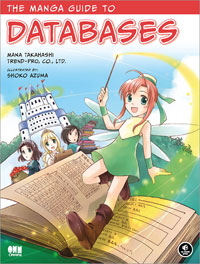
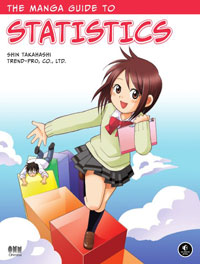
For more commentary see the AICN Anime MySpace.


